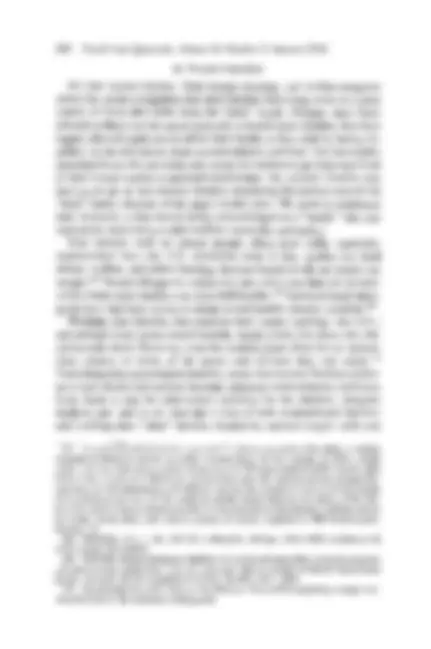


























Study with the several resources on Docsity

Earn points by helping other students or get them with a premium plan


Prepare for your exams
Study with the several resources on Docsity

Earn points to download
Earn points by helping other students or get them with a premium plan
Community
Ask the community for help and clear up your study doubts
Discover the best universities in your country according to Docsity users
Free resources
Download our free guides on studying techniques, anxiety management strategies, and thesis advice from Docsity tutors
The evolving recognition of diverse family structures in public programs, focusing on food stamps, housing, and welfare. The author highlights how some programs have expanded to include cohabiting unmarried couples, gay and lesbian families, single-parent families, and families with children unrelated to their caregivers. However, other programs have moved in the opposite direction, providing more benefits to wealthier families while cutting back on support for poorer ones. The document also explores the historical context of these changes and the challenges they pose for social policies.
What you will learn
Typology: Study Guides, Projects, Research
1 / 32

This page cannot be seen from the preview
Don't miss anything!

























***** Roger J. Traynor Professor of Law, University of California, Berkeley (Boalt Hall).
This article draws on work done in the seminar I taught with Professor Ira Ellman on The Family in Public Programs. Seminar contributors are acknowledged below in the sections rele-
vant to their projects. Considerable general assistance was provided by Christine Fujita, University of California Berkeley (Boalt Hall) class of 2009 and Pam Spritzer, Columbia Law School.
We will see that (^) programs such as Social Security, tax, food stamps, pub- lic housing, welfare, and immigration treat households (^) very differently. Put simply, programs aimed primarily (^) at middle-class and richer fami- lies advantage the traditionally (^) "ideal" nuclear family in which the hus- band goes out to (^) work and the wife stays at home to care for the children. By contrast, at least some public (^) programs aimed at low-income families are much more (^) expansive in the sort of families they recognize. These include cohabitating (^) unmarried heterosexual couples, gay and lesbian families, single-parent (^) families, and families that include children unre- lated (^) to their caregivers by marriage, blood, or adoption. However, even if programs aimed at low-income (^) families are more tol- erant of (^) what constitutes a "family," they are not necessarily more (^) gener- ous to those families, as compared with financially (^) better-off families. Indeed, (^) recent reforms-especially in tax and welfare-have (^) largely moved in the opposite direction, providing (^) more financial benefits to wealthier families while cutting back on (^) support for poorer ones. One could attribute this trend to social disapproval (^) of the wider legal definition of the family in programs aimed at the (^) poor, or simply to social disap- proval of the seemingly greater diversity (^) in family types that we find among the poor. But this does not (^) seem the right explanation. Rather, in my view, at the bottom of these changes (^) is a commitment to the idea that the rich generally deserve their wealth and the poor (^) ought to do more to help themselves. In a study of public programs such as this one, it should be self-evident that an alternative solution lies (^) in political change that would better treat low-income families regardless (^) of their configuration.
I. Changing Social Norms By (^) the 1950s, American law and policy, largely centered on (^) a single vision of the "ideal" family, composed of (^) a married man, who worked in the paid labor force, and his wife, who spent most of her time in (^) their home caring (^) for their biological children. Americans were strongly encouraged to conform to that norm. (^) Other groupings of adults and children-even if they were considered (^) families by some people-were generally disfavored by the predominant social values (and by the public programs) (^) of the time. To be sure, if we look back throughout American history, (^) it has been long understood that not everyone's lives conformed to this "ideal" family.^2 For example, and most dramatically, during times of (^) slavery in America,
Mason, Arlene Skolnick & Stephen (^) D. Sugarman eds., 2d ed. 2002) [hereinafter ALL OUR FAMILIES].
2. See generally (^) STEVEN MINTz, HUCK'S RAFT: A HISTORY OF AMERICAN CHILDHOOD (2004).
structure, there remained a strong societal preference for the "ideal" nuclear family. 8 "Broken" families were viewed by mainstream society as failures. Single women having children outside of marriage were highly stigmatized, and their children were disparaged as "bastards." Unmarried couples living together "in sin" were scandalous. Homosexual (^) couples were closeted, and the very idea of same-sex relationships was generally abhorred. This preference for the traditional nuclear family was broadly rein- forced by American laws and policies. For example, (^) on the private law side, divorce was not easy to obtain and was widely (^) disfavored; 9 and inheritance laws generally failed to recognize children born out of wed- lock.' °^ On the public side, the Social Security system, which was put into place in the 1930s, was structured to favor the two-parent family with the father working for wages and the (^) mother at home raising the children." Federal income tax laws favored married couples over unmarried individ- uals, and, among married couples, financial advantages flowed to single- breadwinner households.1^2 Although the welfare system somewhat grudg- ingly provided financial help to poor single mothers of (^) young children, it was based^ on^ the^ assumption^ that^ recipients^ were^ unlucky^ widows.'^^3 Today, things are very different. To be sure, many Americans who self- identify with what is termed the "family values" (^) crowd still idealize the stable nuclear family in which the husband works for wages and the wife stays at home and cares for the children. 4 On the other hand, many have challenged this narrow vision of the family, disputing the notion that this sort of family is morally superior or necessarily best for children and for society in general.' 5 Nowadays there is much more social acceptance of many other types of families. Perhaps most surprisingly, there seems to be growing support for legal
AMERICA'S CHANGING FAMILIES (1997); STEPHANIE COONTZ, MARRIAGE: A HISTORY (2005).
and societal recognition, particularly in fairly liberal urban^ centers,^ of^ sta-
ble, loving relationships formed by gay and lesbian couples. 16 Further,
there is increasing acceptance of the fact that gay and^ lesbian parents,
whether "domestic partners" or truly "married couples,"^ can^ successfully
raise children together (even if the children are^ not^ their^ joint^ biological
creation). Indeed, apart from their homosexual character,^ many^ of^ these
families are touted as exemplifying the norms of^ 1950s^ family^ life,^ with
one predominant earner and one predominant child^ raiser.
In addition, as a result of both "women's liberation" and the^ higher^ cost
of maintaining what are now often viewed as the material requirements^ of a
middle-class lifestyle, more and more couples^ find^ that both^ of^ the^ partners are in the paid labor force. 7 Today, a majority of mothers work^ for^ money, even if they work fewer years and hours (and are paid less) than fathers.^ And while there^ is^ considerable^ anguish^ even^ among feminists about^ how women are to balance their roles as wage earners and mothers, it^ is^ simply^ no^ longer the case that the clearly preferred social norm is^ for^ women^ to^ retreat^ from the workplace^ for^ as^ long^ as^ they have young^ children.'^
Moreover, divorce today is^ easy^ to^ obtain,^ far^ more^ common,^ and much more accepted than it was in 1950,19 and,^ in^ turn,^ because^ of^ remarriage, stepfamilies are also far more numerous than before.^ (^20) Furthermore, hav-
ing a child out of^ wedlock,^ living^ as^ a^ long-term^ single-parent,^ and^ cohab- iting without marrying are^ much^ less^ stigmatized^ and^ far^ more^ frequent than before^ (especially^ among^ white Americans).^
THE Two-INCOME TRAP (2003).
A (^) few specific additional points should be noted about the 1939 fami- ly benefits provisions. First, if the wife had also earned (^) a retirement pen- sion on the basis of her own paid wages, then her own pension benefit would reduce, dollar-for-dollar, the amount of the pension benefit that would otherwise be paid to her because she was (^) a spouse. 25 This meant that a large proportion of women who worked in the paid labor force gen- erally received pensions that were no larger than what they would have received had they remained in the home. This rule clearly favored the stay-at-home wife. Second, if the spouses had divorced before the man retired or died, no benefit would be paid to the divorced woman-thereby favoring long-intact marriages. 26 Third, if the couple was not (^) recognized as married under state law, then the woman would not qualify for benefits as a spouse, even if the couple had lived together and she had been long- dependent on the man's income. 27 Fourth, generally speaking, the chil- dren's benefits were reserved for the legitimate biological children, stepchildren, and legally adopted children of married couples.2 8^ Overall, then, the initial parameters of the family benefit features of Social Security plainly favored the "ideal" family described earlier. Since 1950, however, the scheme has been amended to recognize some, but only some, (^) of the now more openly tolerated family types. For exam- ple, spousal benefits were extended to some divorced women, first for those who had been married for twenty years, and later for those who had been married for ten years. 29 In addition, more and more children were
added to the list of those who qualified as "dependents" and hence eligi- ble for children's benefits through Social (^) Security. By now nearly all stepchildren and most children born (^) out of wedlock will qualify. 3 " On the other hand, it is important to appreciate the limited nature (^) of Social Security reform. First, domestic (^) partners (that is, unmarried couples, whether heterosexual or homosexual) still do not qualify for (^) spousal benefits. That is, it does (^) not suffice to live together, to self-identify as a "couple" (^) and to be (^) financially interdependent. (^) Indeed, (^) the Defense of Marriage Act, 3 ' enacted in 1996 in response to state (^) law changes with respect to gay and lesbian couples, explicitly denies (^) Social Security benefits to same-sex domestic partners even if they are or were to be rec- ognized as married under state law-a sharp departure from the program's traditional deference to state law as the ground for deciding whether some- one is a spouse. Second, and perhaps equally important, the benefit struc- ture of Social Security still strongly favors one-earner couples (indeed the spousal benefit for widows has been enhanced over the years). 32
U.S. federal income tax law 33 continues to be much like Social Security. Two points stand out. First, under our progressive income tax scheme, couples who can combine and in effect average down their income gain the benefit of lower marginal tax rates than would be applied
claim to such support. Social Security Act Amendments of 1965, Pub. L. No. 89-97, § 308, 79 Stat. 286, 375 (codified as amended at 42 U.S.C. § 402(b), (g) (2000)). Congress eliminated the support requirement in 1972 and lowered the required duration of marriage to ten years in 1977. Social Security Act Amendments of 1972, Pub. L. No. 92-603, § 114, 86 Stat. 1329, 1348 (codified as amended at 42 U.S.C. § 402(b), (g) (2000)); Social Security Act Amendments of 1977, Pub. L. No. 95-216, § 337, 91 Stat. 1548 (codified as amended at 42 U.S.C. § 402(b), (g) (2000)).
U.S.C. § 1738C (2000) (providing that no state (^) is required to give any effect to a law that treats a "relationship between persons of the same (^) sex as marriage")).
who are far less likely to pay for child care (although employed single
mothers can also benefit from the credit). Hence, this reform is a sharp
break from the long-standing favoritism of one-earner couples. Partly in
response to a political backlash to that provision, a general Child Tax
Credit (CTC) of $1,000 annually is now also provided to non-high-earner
parents, including^ those^ who^ care^ for^ their^ own^ children.^
Perhaps the most important change with respect to families in the past
several decades has been the adoption of the Earned Income Tax Credit
(EITC), which primarily provides money to working-class parents with
quite modest earnings.^4 " This is a "refundable" credit, which means that
claimants are eligible for the credit even if they otherwise owe no taxes.
Although both married and single taxpayers may claim the (^) EITC, they
have to have earned income to qualify, and hence, at least for single par-
ents, this provision plainly encourages mothers to take paid work.
Ironically, because of the way the EITC is structured, low-income couples
can face a marriage penalty that is somewhat analogous to the "marriage
tax" faced by married couples with higher (and relatively equal) incomes.^4
Finally, there is yet another parallel to Social Security. At the level of the couple, the main tax benefits attached to having children (the CTC and
EITC) narrowly define the family by requiring marriage. Yet, at the child
level, these provisions are more generous as they include, for example,
children born out of wedlock. Indeed, in one respect, tax law has had a
longstanding (^) tolerance as to which children may be deemed part of the
family. Tax exemptions, which may be claimed for "dependents," are
39. The Child Tax Credit was enacted as part (^) of the Tax Payer Relief Act of 1997, Pub. L. No. 105-34, tit. I, § 101(a), III Stat. 796 (1997) (codified as amended at I.R.C. § 24 (2000)). The purpose was to reduce tax liability to reflect "a family's reduced ability to pay taxes as fam- ily size increases." Id. Congress believed providing a tax credit for families with dependent chil- dren would better recognize the financial responsibilities of raising children and promote fami- ly values. H.R. Rep. No. 105-148, at 310 (1997).
available with^ respect^ to^ any^ child^ (even^ if^ legally^ completely^ unrelated^ to
the taxpayer) so long as the child lives with, and is financially supported
by, the claimant.^42
Thus, when it comes to couples, tax law is, broadly speaking, like
Social Security in its favoritism of "ideal" families. And yet, also like
Social Security, it has come some way in acknowledging a^ broader^ range
of parent-child relationships in American families. Given^ the^ continuing
political strength of well-off married couples^ with^ one main^ breadwinner,
it is not surprising to see the ongoing bias at the couple level in both the
tax and Social Security programs.
C. Food Stamps
The Food Stamp Program,^43 adopted in its current form in the 1960s,
stands in sharp^ contrast^ to^ both^ Social^ Security^ and tax law.^ Food^ stamps
provide funds to low-income households for the purchase of approved
food items." Unlike Social Security, which is available to anyone who
works in covered employment, or tax law, which is primarily aimed at the
"haves" rather than the "have-nots," the Food Stamp Program is a "means-tested" program restricted (^) to those with immediate (^) financial need.
The theme to be emphasized here, however, is the considerable difference
between the programs in terms of what sorts of families they recognize.
Because the Food Stamp Program is structured around "household"
eligibility, this^ means^ that^ many groups^ who^ are^ not^ treated^ as^ families
by Social Security or tax law can obtain food stamps as a unit. 45 Most
strikingly, these include families headed by unmarried cohabitants-both
heterosexual and homosexual. Single mothers qualify for food stamp just
as readily as couples, and indeed, the largest category of food stamp
The legal structure of our public-housing (^) schemes 5 2^ broadly parallels the Food Stamp (^) Program. The United States has two major public-hous- ing programs. (^) In one, the government owns housing and makes units available to needy people at low cost; in the other, commonly known as Section 8, the government subsidizes the rental of privately owned hous- ing that is rented to those in need. In both of these programs, there is, at least formally, a great tolerance for all sorts of family structures.^53 Single mothers and their children qualify for public-housing units (whether the mothers are widows, divorcees, or never-married). (^) So, too, unmarried cohabiting couples (^) with children qualify for public housing slots, at least so long as they are poor enough to be eligible. (^) Indeed, there is nothing in the official housing policies that would make gay and lesbian applicants ineligible, provided (^) they otherwise qualify. And, it is considered altogether appropriate (^) to award apartment units with an adequate number of bedrooms to poor families that are raising children who are neither their biological nor adopted children (for example, (^) nephews and nieces). This is not to say that there are no difficulties faced by non-"ideal" fam- ilies connected (^) to public housing. For one thing, many low-income fami- lies have (^) unstable family structures, and housing authorities often have difficulties with these arrangements. After all, moving people from (^) one apartment (^) to another as family structure changes (because of a correspon- ding change in the size of the housing unit for which the family would seemingly now qualify) is cumbersome and often practically impossible. Moreover, it can be especially problematic if a single woman living in a
public-housing unit wants to bring a man to live in her apartment. Then
the authorities want information regarding his income, how much he will
contribute to the rent, and so on. If the woman's relationship with the man
is fairly new, she might well be unsure how long it will last and how much
of a contribution he will reliably provide. This tempts some women to
above, the Social Security system was amended in 1939 to provide
survivors' benefits for widows and their children, many envisioned that
this change would, over time, largely eliminate the need for means-tested
welfare. But changes in family structure produced all sorts of new poor,
single-parent families who obtain welfare benefits. Today these families
are mainly composed of never-married or divorced mothers and their
children.
On the one hand, therefore, the continued existence of the welfare sys-
tem suggests continued social support for family structures other than the
idealized two-parent family and unlucky widowed mothers. Yet, support should not be confused with embrace. These divorced and never-married mothers are helped for the sake of their children, and government has few
qualms against intrusive regulation of the lives of those (^) on the welfare
rolls. Three aspects of their behavior have attracted special attention: their
sexual conduct, their work outside the (^) home, and their eventual marriage (or (^) remarriage). Early on, the welfare system sought to enforce the norm that "proper" women do not have sex outside of marriage. Authorities monitored the
conduct of welfare recipients and threatened to cut off aid to "misbehav-
ing beneficiaries." 6 Moreover, it was well understood that if single moth-
ers on welfare had sexual relations, then some of them would have more
children, increasing the cost of the program. The likely cost increase was
undesired by those in power and hence to be discouraged. Besides, those
extra children would be born out of wedlock, and that was seen as highly
unfavorable for the children themselves. Finally, if single women could be
prevented from having sexual (^) relations while on welfare, this might
encourage them to marry, which was expected to have several additional
benefits for the woman, her children, and society at large.
Social Security Act of 1935. Social Security Act of 1935, ch. 531, tit. (^) IV, § 401, 49 Stat. 620, 627 (codified as amended at 42 U.S.C. §§ 601-619 (2000)).
As for working outside the home, starting in the 1970s and as a result
of altered social norms in society at large, political attitudes changed con-
cerning the employment (^) obligations of welfare mothers. Before that, the
general understanding was that these claimants would be stay-at-home
mothers, raising their children in parallel to married mothers whose hus-
But this outlook shifted, and over the next thirty (^) years increasingly tough
work requirements were imposed on (^) welfare claimants.^7 "
By the time PRWORA was enacted (^) in 1996, work requirements
seemed totally unremarkable. If so many middle class and professional
women were in the paid labor force,^71 how could society justify allowing
(requiring states to submit plans establishing goals and to take action to (^) prevent and reduce the incidence of out-of-wedlock (^) pregnancies); id. at § 403(a)(2)(B) (codified as amended at 42 U.S.C. § 603) (offering a $20 million bonus to states that decrease the number of illegitimate births by a certain amount). PRWORA also left intact the ability of states (^) to enact "family caps" to prohibit an increase in (^) benefits when welfare recipients have additional children. Since pas- sage of the Act, twenty-three states have decided (^) to continue to utilize caps already in place or to create new ones. Wendy Chavkin et al., Sex, Reproduction, and Welfare Reform, 7 GEO. J.
WOMEN IN THE LABOR FORCE: A DATABOOK, Report 985 (2005). From 1975 to 2000, the rate of working mothers with children under age eighteen rose from forty-seven percent to seventy- three percent. Id. In 1996, when Congress passed PRWORA, (^) about sixty-three percent of women were employed. Id. Women have also made substantial inroads into higher paying occu- pations. In 2004, half of all management, (^) professional and related occupations were held by women. Id.
low-income women to remain at home living on the "dole?"
Conservatives suggested that welfare mothers were lazy women who sat
around watching TV, perhaps^ doing^ drugs^ and^ having^ sex.^ These^ critics
forcefully argued that these women should be working. The reality was
often very^ different^ from^ what^ this^ image implied.^ In fact,^ many^ welfare
claimants were^ actually working^ for^ money,^ at^ least^ part-time. (^72) These
women worked if for no other reason than because they could not reason- ably support their children^ and^ themselves^ on the^ meager^ funds provided
by government. But they often took black market, sometimes^ illegal^ and
often dangerous jobs, because they had to keep their earnings secret from the welfare office (even though this was a crime). Otherwise, their earned income would primarily have the effect of reducing their^ aid.^ Liberals were generally unwilling to admit^ that^ welfare^ claimants^ might^ be engaged in this sort of fraud; hence, they tended to portray these women as staying at home and devoting themselves to being the best mothers they could be under the circumstances. Now that work requirements are tougher,^7 3 many women on welfare find themselves financially no better off and sometimes worse off. They take officially recognized jobs at the government's insistence, but in turn they receive somewhat reduced aid-in^ contrast^ to^ their^ prior^ state^ of^ illic- itly combining^ aid^ with^ unreported^ earnings.^ In^ any^ event,^ it^ is^ now^ wide- ly accepted as appropriate to force these single mothers out of the home and into the job market since that is the situation in^ which^ so^ many^ other working-class (and^ even financially^ better^ off) mothers^ find^ themselves.
Ironically, this policy of coercing labor-force participation by welfare claimants still does not^ exist^ in^ the^ Social^ Security^ system.^ There,^ a younger widowed mother caring^ for^ children^ can^ claim^ benefits^ without